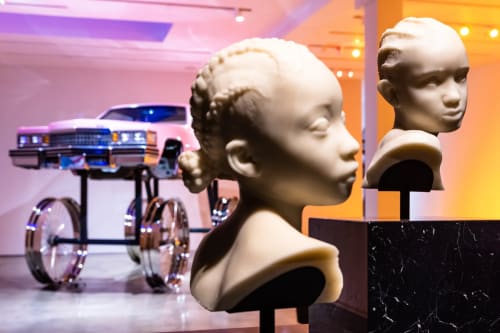
The light is dim and inviting. An orange glare creates a warm, comfortable atmosphere, making the gallery glow. The environment is soft; almost meditative. Very intentionally positioned dandelions line the floor turning it into an indoor field ready to be run through. “Faith in the Seeds” pays tribute to Black people killed by police violence but also to their perseverance under harsh circumstances. That’s why every single dandelion is made of black steel.
A pink Cadillac shines in the distance. Elevated so high off the ground that the viewer can walk under it, the sculpture presents a shell of the car—its insides removed. The Cadillac, complete with an American flag vanity license plate reading “In God We Trust,” has become an iconic part of Black culture. Presented in a gallery setting—polished, untouchable—Nirvana (Oh, Sweet Elham) is Esmaa Mohamoud’s way of commenting on the fact that Black people were systematically barred from purchasing luxury automobiles in the early-twentieth century.
Across the room, Gluttony, Gluttony, Gluttony presents three sculptures, each carved of solid shea butter. Bringing Roman statues to mind, the busts take the shape of the young African girls who have historically harvested shea nuts in Africa. All around them: 15,000 sculpted shea butter nuts, cast from real Ghanaian shea nuts. The artist highlights labor, exploitation and the fact that Ghana produces around 130,000 tons of shea butter per year—a beauty product primarily used for Black hair and skin.
A pitch-black, sky-high rattan chair completes the ensemble. A Seat Above the Table (Angela Bassett) extends at twelve-feet tall essentially spotlighting the unattainable standards that have been defining the Black experience. Upon a closer look, one finds out that the original peacock chairs were woven by prisoners in the colonized Philippines. Between cryptic, explicit and borderline predictable cultural criticism, the symbolism in Mohamoud’s work is once again striking.
The African Canadian sculptor and installation artist draws inspiration from recent history to reexamine and reframe understandings of contemporary Blackness. But she doesn’t merely question definitions of Black as a skin color—she also considers the impact of political, economic, sociocultural, environmental and other external influences. Then, she looks at it as part of personal and collective identity.
Discriminatory behavior, racial marginalization, violence and inequality all come into play in Let Them Consume Me In The Light—an exhibition that invites you to do just that. “They should consume us in the light of the truth, in the light of racial injustice, in the light of the things we don’t usually want to talk about,” she prompts. “They’re already gonna consume us, it might as well be out in the open.”
But Mohamoud’s work doesn’t focus solely on struggle—it is grounded on strength and self-preservation. As a result, it is within the healing light, fit for quiet contemplation and restoration of inner peace, that one cannot help but wonder: How do I perceive Blackness?

